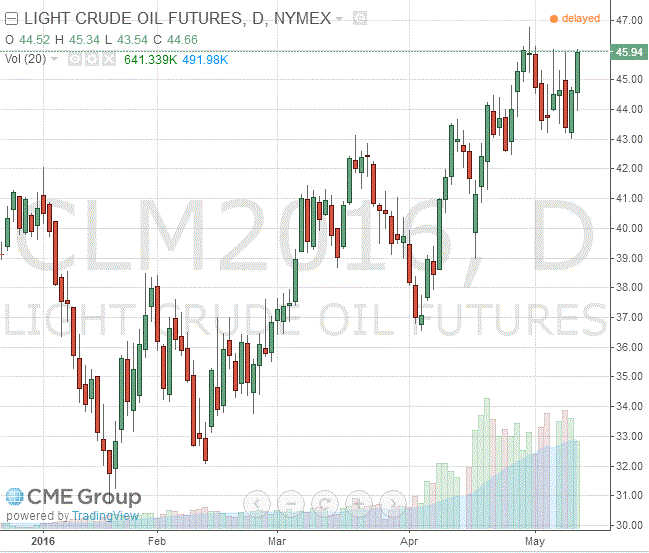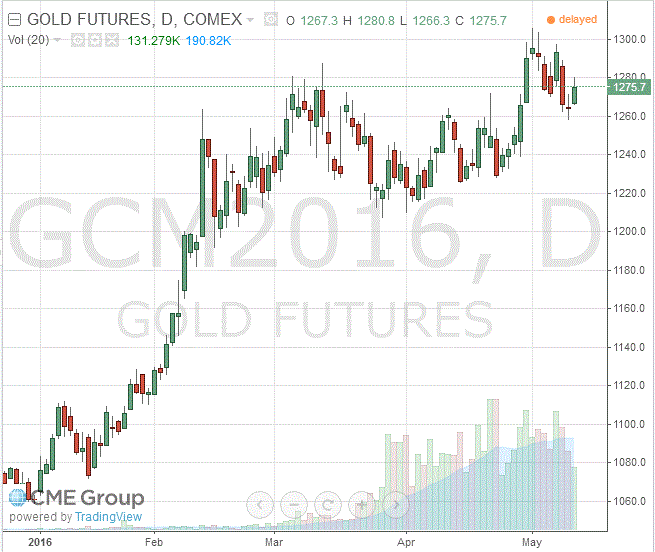Noticias del mercado
-
17:43
Oil demonstrates positive dynamics
The cost of oil futures rose sharply, again returned to positive territory, helped by data from the US Department of Energy, who reported an unexpected decline in crude oil inventories.
US Department of Energy report showed that in the week of April 30 - May 6 crude oil inventories fell by 3.4 million barrels to 540 million barrels. Analysts on average had expected an increase of 0.5 mln. Barrels. Oil reserves in Cushing terminal rose by 1.5 million barrels to 67.8 million barrels. Gasoline inventories fell by 1.2 million barrels to 240.6 million barrels. Analysts had expected stocks will decline by only 0.6 million. Barrels. Meanwhile, distillate inventories decreased by 1.6 million barrels to 155.3 million barrels. Analysts expected distillate stocks to decrease by 0.8 million. Barrels. The utilization of refining capacity fell 0.6% to 89.1%. Analysts expected an increase of 0.5%. It was also reported that oil production in the US in the week from 30 April to 6 decreased to 8.802 million. Barrels per day versus 8.825 million barrels per day in the previous week.
Recall yesterday's data from the American Petroleum Institute pointed to the opposite situation with petroleum products. According to the report, for the week US crude stocks rose 3.45 million. Barrels. The gain was the largest for 5 weeks. Meanwhile, stocks in the Cushing terminal rose by 1.46 million barrels. Distillate stocks in the US for the week fell by 1.4 million barrels, while gasoline stocks rose 0.3 million barrels.
Support prices also have reports of disruption of oil supplies from Nigeria. Today, Shell Petroleum Development Division announced the event of force majeure related to the export of Bonny Light crude oil. Against this background, oil production in the country could fall to a more than 20-year low. Meanwhile, the Libyan National Oil said it would be forced to suspend production at the fields, providing the bulk of the country's oil exports for a month, if the insurgents will not remove the blockade of the port.
However, experts say that the world's oil reserves are near record highs, and some supply disruptions little that this will change, as the decline in production in some OPEC countries offset by growth of exports from Iran and nearly a record oil production in Saudi Arabia and Russia .
WTI for delivery in June rose to $45.94 a barrel. Brent for June rose to $47.09 a barrel.
-
17:32
China's vice premier Zhang Gaoli: China will reach its economic growth target this year
China's vice premier Zhang Gaoli said on Wednesday that the country would reach its economic growth target this year. China expects its economy to expand 6.5%-7.0% in 2016, after a 6.9% growth in 2015.
Zhang noted that China's economy remained resilient.
-
17:22
Gold prices rose today
Gold has risen in price moderate, departing from two-week low as the dollar rally stalled and European stocks fell, which increased investors' appetite for safe assets. Support prices have also hopes that the Fed will not raise interest rates at the June meeting.
According to analysts, in the near future, the level of $ 1,300 will act as a strong barrier. It is worth emphasizing, since the beginning of the year the precious metal quotes have increased by almost 20 percent against the background of large-scale gold inflows to funds and reduce the likelihood of Fed rate increase in the near future. Recall increase in rates is usually a negative impact on gold prices as the precious metal can not compete with the assets, income, when borrowing costs rise.
"The increase in gold prices will be limited, as the Fed little chance to surprise the markets" in a bad way ", and the space for the weakening of the dollar also has its limits", - experts said Goldman Sachs. However, Goldman Sachs increased its forecasts for gold prices in the coming months, citing the strong net speculative positioning. According to the new estimates, the price of gold will be $ 1,200 in three months, $ 1180 in six months and $ 1,150 in 12 months. Previously, prices were projected at $ 1,100, $ 1,050 and $ 1,000, respectively. Also, Goldman Sachs analysts expect that the Fed will raise rates in September, but also do not exclude such a possibility at the July meeting, if the US economy will show steady growth. Meanwhile, according to the quotations of futures on a bet the Fed, traders estimate the probability of a July rate increase of 21%.
The cost of the June gold futures on the COMEX rose to $ 1275.7 per ounce.
-
16:47
U.S. crude inventories decline by 3.4 million barrels to 540.0 million in the week to May 06
The U.S. Energy Information Administration (EIA) released its crude oil inventories data on Wednesday. U.S. crude inventories declined by 3.4 million barrels to 540.0 million in the week to May 06.
Analysts had expected U.S. crude oil inventories to rise by 0.5 million barrels.
Gasoline inventories decreased by 1.23 million barrels, according to the EIA.
Crude stocks at the Cushing, Oklahoma, climbed by 1.52 million barrels.
U.S. crude oil imports fell by 5,000 barrels per day.
Refineries in the U.S. were running at 89.1% of capacity, down from 89.7% the previous week.
Oil production fell by 0.3% last week to 8.802 million barrels a day from 8.825 million barrels a day in the previous week.
-
10:34
Head of research at state-owned oil company Kuwait Petroleum Corp., Abdulaziz Al Attar: Kuwait plans to almost double its oil output by 2020
Head of research at state-owned oil company Kuwait Petroleum Corp., Abdulaziz Al Attar, said on Tuesday that Kuwait planned to almost double its oil output by 2020 reaching 4 million a barrels a day. The country's oil production totalled 2.77 million barrels a day in March.
Al Attar noted that Kuwait planned to expand its domestic refining capacity to 1.4 million barrels a day and boost international cooperation.
-
00:38
Commodities. Daily history for May 10’2016:
(raw materials / closing price /% change)
Oil 44.57 -0.20%
Gold 1,267.40 +0.21%
-

